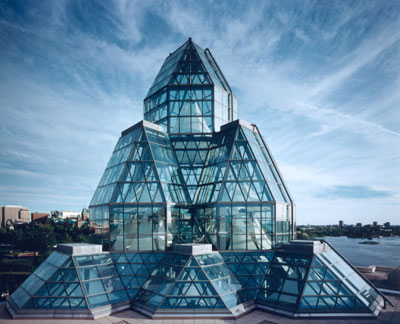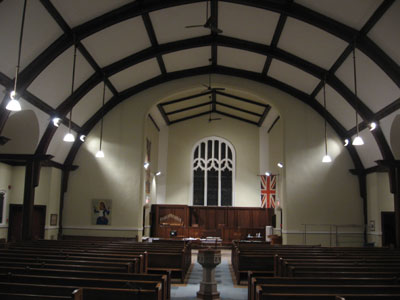SAVE!
Keep your Norval Morrisseau admission ticket and get $2 off you ticket to the Sunil Gupta and Imprints exhibitions at the Canadian Museum of Contemporary Photography, until 23 April 2006. Some restrictions may apply.
AUDIOGUIDES
Bell audioguides highlight many works of art from the permanent collection in English, French, Spanish, German, and Mandarin ($3). Available in the Great Hall.
ADVANCE TICKET SALES
Except where noted, you may obtain tickets or register for programs either in person or by calling (613) 998-8888 or 1-888-541-8888 (service charges apply on purchases by phone). All prices include taxes.

Emily Carr
Blunden Harbour c. 1930
oil on canvas, 129.8 x 93.6 cm
National Gallery of Canada, Ottawa
Purchased 1937
Photo © National Gallery of Canada
5. Please tell us more about the building that the National Gallery is located in.
Created as a permanent home for the institution in 1988, the building was conceived by internationally renowned architect Moshe Safdie, the Gallery’s design echoes the near Library of Parliament, and mirrors the soaring spaces of Notre-Dame Basilica opposite. At it’s heart lies a unique treasure: the reconstructed nineteenth-century Rideau Street Convent Chapel. The Great Hall the Gallery’s principal ceremonial space, was designed as a tribute to the Parliamentary Library, itself a Victorian reinterpretation of a polygonal Gothic chapter house.
The Taiga Garden located next to the Amphitheatre makes a symbolic reference to Canada’s northern climate and typically rugged terrain. Conceived by the landscape architect Cornelia Hahn Oberlander, the garden design was inspired by the slabs of rock into which the Gallery was built.
Inside the Gallery, water and garden courtyards provide peaceful spaces, inviting visitors to pause and reflect.

National Gallery of Canada, Rideau Street Convent Chapel
6. What is the National Gallery’s mission?
The strength of the National Gallery of Canada lies in its collection of art, especially Canadian art, and its accessibility to the public across the country. The collection opens the way for appreciation of the finest in artistic expression, with works of art that reveal the past, celebrate the present, and probe the future. The collection must be expanded, preserved, interpreted and used to the utmost by the public for pleasure and understanding, for research and the advancement of knowledge.
The mandate of the National gallery, as set out in the 1990 Museums Act is: to develop, maintain and make known, throughout Canada and internationally, a national collection of works of art, historic and contemporary, with special but not exclusive reference to Canada; and to further knowledge, understanding and enjoyment of art in general among all Canadians.
The National Gallery of Canada strives to provide Canadians with a sense of identity and pride in Canada’s rich visual arts heritage and to make art accessible, meaningful and vital to diverse audiences of all ages.

Kwakwaka’wakw Artist
Mask 19th century
Cedar (?), hair, fur, pigment
The British Museum, London
7. Please tell us about the collections featured at the National Gallery.
The National Gallery of Canada’s collection of Canadian art including Inuit Art, assembled since 1880, is the most comprehensive and important in existence. The Gallery also has a fine collection of Western European art dating from the late Middle Ages to the present, including prestigious collections of important prints, drawings and photographs. The international works help place Canadian art in its broader context by demonstrating the influences on and evolution of the visual arts in Canada.
The Gallery’s collection consists of over 37,000 works of art, acquired either by purchase or as gifts. About 1,200 to 1,500 of the most significant of these works – over 20% of its paintings and sculptures – are on view over the course of the year in the Permanent Collection galleries. Works in the Gallery’s Prints, Drawings and Photographs collections are featured in a program of rotating exhibitions, and about 3,000 square feet of Gallery space is dedicated to the display of contemporary Canadian art.
The CMCP collection holds over 161,000 images by contemporary Canadian photographers, of which 144,000 are negatives or transparencies and 17,000 are prints. Works in the CMCP collection are also featured in a program of rotating exhibitions.

National Gallery (right), Canadian Parliament Buildings (left)




